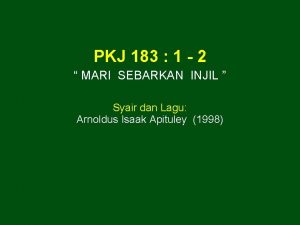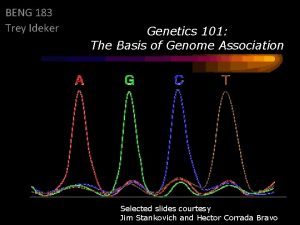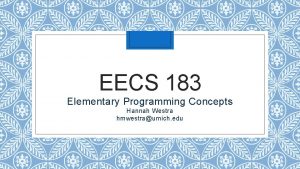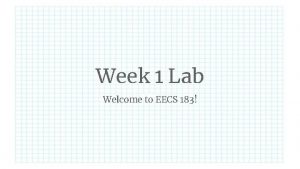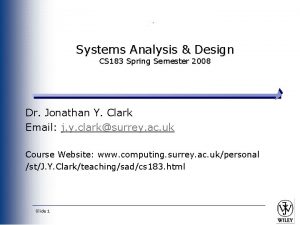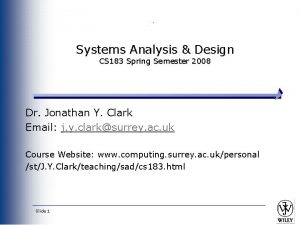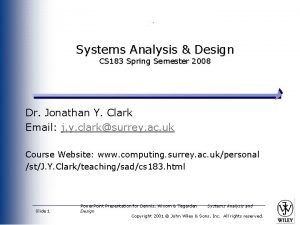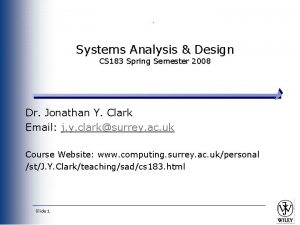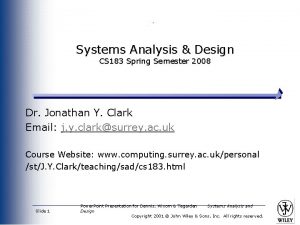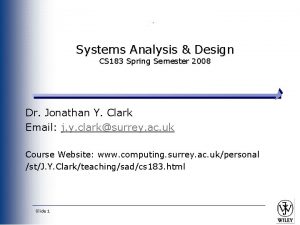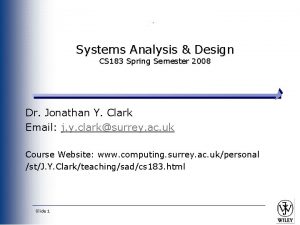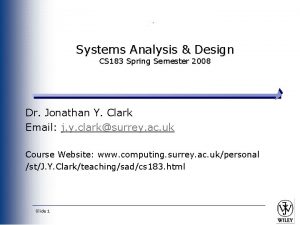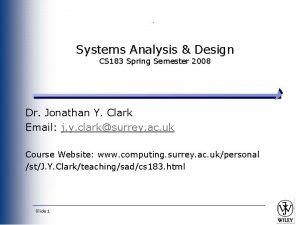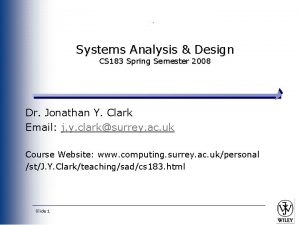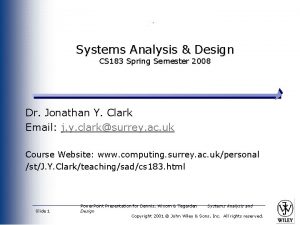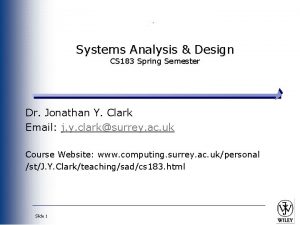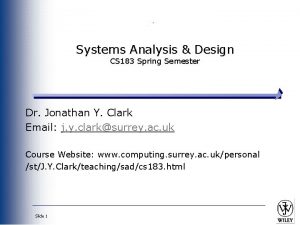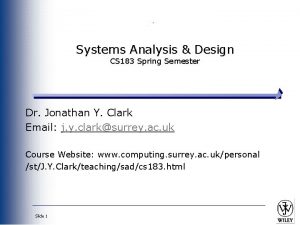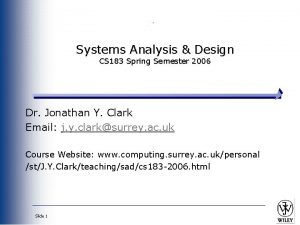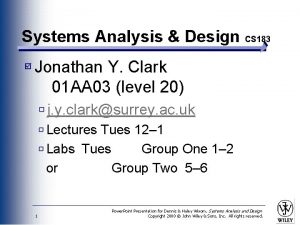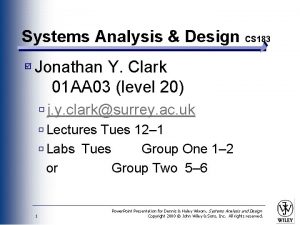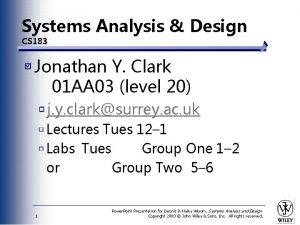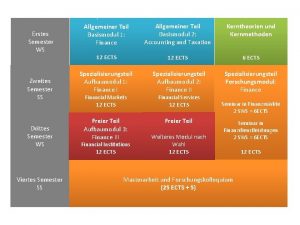Systems Analysis Design CS 183 Spring Semester 2008



































- Slides: 35

Systems Analysis & Design CS 183 Spring Semester 2008 Dr. Jonathan Y. Clark Email: j. y. clark@surrey. ac. uk Course Website: www. computing. surrey. ac. uk/personal /st/J. Y. Clark/teaching/sad/cs 183. html Slide 1

Course Textbook: Systems Analysis and Design With UML 2. 0 An Object-Oriented Approach, Second Edition Chapter 1: Introduction to Systems Analysis and Design Alan Dennis, Barbara Wixom, and David Tegarden © 2005 John Wiley & Sons, Inc. Slide 2

Adapted from slides Copyright © 2005 John Wiley & Sons, Inc. Slide 3

INTRODUCTION Chapter 1 Slide 4

Key Ideas Many failed systems were abandoned because analysts tried to build wonderful systems without understanding the organization. The primarily goal is to create value for the organization. Quality is satisfaction of requirements, not ‘goodness’ Slide 5

Key Ideas The systems analyst is a key person analyzing the business, identifying opportunities for improvement, and designing information systems to implement these ideas. It is important to understand develop through practice the skills needed to successfully design and implement new information systems. Slide 6

THE SYSTEMS DEVELOPMENT LIFE CYCLE (SDLC) Slide 7

Major Attributes of the Lifecycle The project Moves systematically through phases where each phase has a standard set of outputs Produces project deliverables Uses deliverables in implementation Results in actual information system Uses gradual refinement Slide 8

4 Main Project Phases Planning Why build the system? Analysis What, when, where will the system be? Design How will the system work? Implementation System construction & delivery Slide 9

Planning Identifying business value (is it worth doing? ) Analyze feasibility (is it possible? ) Develop work plan (when? ) Staff the project (who? ) Control and direct project Slide 10

Analysis (what do we want? Who will use the system? ) Information gathering Process modelling (what happens? ) Data modelling (… and to what? ) Slide 11

Design strategy Architectural design Interface design (HCI) Database and file design Program design (what will the programs do? ) Slide 12

Implementation Construction (Programming, testing, validation etc) Installation (including migration, change management) Slide 13

Processes and Deliverables Process Planning Project Plan Analysis System Proposal Design Implementation Slide 14 Product System Specification New System and Maintenance Plan

SYSTEM DEVELOPMENT Methodologies Slide 15

What Is a Methodology? A formalized approach or series of steps Writing code without a wellthought-out system request may work for small programs, but rarely works for large ones. Slide 16

System Development Methodologies 1. 2. 3. Structured Design Rapid Application Development Agile Development Slide 17

1. STRUCTURED DESIGN Projects move methodically from one to the next step Generally, a step is finished before the next one begins Slide 18

Waterfall Development Method Slide 19

Pros and Cons of the Waterfall Method Pros Identifies systems requirements long before programming begins Cons Design must be specified on paper before programming begins Long time between system proposal and delivery of new system Slide 20

Parallel Development Slide 21

2. RAPID APPLICATION DEVELOPMENT (RAD) Critical elements CASE tools JAD sessions Fourth generation/visualization programming languages Code generators Slide 22

Rapid Application Development Categories Phased development ± a series of versions, later combined Prototyping ± System prototyping Throw-away prototyping ± Slide 23 Design prototyping

Phased Development Slide 24

How Prototyping Works Slide 25

Throwaway Prototyping Slide 26

3. AGILE DEVELOPMENT Simple iterative application development Extreme programming (XP) Slide 27

Extreme Programming (XP) Key principles Continuous testing ± Simple coding by pairs of developers ± Close interactions with end users ± Testing & Efficient Coding Practices ± Integrative testing environment Requires… Stable and experienced teams ± Small groups of developers (<=10) ± Slide 28

Extreme Programming (XP) Slide 29

Selecting the Appropriate Methodology Clarity of User Requirements Familiarity with the Technology System Complexity System Reliability Length of Time Schedules Time Schedule Visibility Slide 30

Criteria for Selecting a Methodology Slide 31

Project Team Roles and Skills Slide 32

Project Team Roles Business analyst (business value) Systems analyst (IS issues) Infrastructure analyst (technical issues – how the system will interact with the organization’s hardware, software, networks, databases) Change management analyst (people and management issues) Project manager (budget, time, planning, managing) Slide 33

Summary The Systems Development Life Cycle (SDLC) consists of four stages: Planning, Analysis, Design, and Implementation The Major Development Methodologies: Structured Design ± ± Waterfall Method Parallel Development Rapid Application Development (RAD) ± ± ± Phased Development Prototyping (system prototyping) Throwaway Prototyping (design prototyping) Agile development ± e. Xtreme Programming Project Team Roles Slide 34

Summary -- Part 2 There are five major team roles: business analyst systems analyst infrastructure analyst change management analyst project manager. Slide 35
 2008 2008
2008 2008 Kim ki duk summer fall winter spring
Kim ki duk summer fall winter spring Spring, summer, autumn winter months
Spring, summer, autumn winter months Turkish airlines flight tk 183 bermuda
Turkish airlines flight tk 183 bermuda Convenio 183
Convenio 183 Lagu pkj 183
Lagu pkj 183 Ki kd al qur'an hadits ma
Ki kd al qur'an hadits ma Katherine kampf
Katherine kampf Convenção 183 oit
Convenção 183 oit Beng 183
Beng 183 Eecs 183 ia
Eecs 183 ia Eecs 183 lab 8
Eecs 183 lab 8 Eecs 183 project 3
Eecs 183 project 3 Cs 183
Cs 183 Gül kerman
Gül kerman Spring information systems
Spring information systems Systems analysis and design in an age of options
Systems analysis and design in an age of options System analysis
System analysis Systems analysis and design in a changing world
Systems analysis and design in a changing world System analysis and design in a changing world
System analysis and design in a changing world Systems analysis and design alan dennis
Systems analysis and design alan dennis Introduction of system analysis and design
Introduction of system analysis and design Ssadm model
Ssadm model Case tools are limited to systems analysis.
Case tools are limited to systems analysis. Modern systems analysis and design
Modern systems analysis and design Kendall and kendall system analysis and design
Kendall and kendall system analysis and design Systems analysis and design alan dennis
Systems analysis and design alan dennis Systems analysis and design alan dennis
Systems analysis and design alan dennis Systems analysis and design alan dennis
Systems analysis and design alan dennis Systems analysis and design alan dennis
Systems analysis and design alan dennis Systems analysis and design alan dennis
Systems analysis and design alan dennis Systems analysis and design alan dennis
Systems analysis and design alan dennis Systems analysis and design alan dennis
Systems analysis and design alan dennis Ssadm
Ssadm Radar range equation snr
Radar range equation snr Object-oriented systems analysis and design using uml
Object-oriented systems analysis and design using uml





